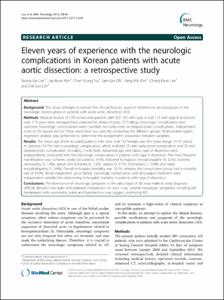KUMEL Repository
1. Journal Papers (연구논문)
1. School of Medicine (의과대학)
Dept. of Thoracic & Cardiovascular Surgery (흉부외과학)
Eleven years of experience with the neurologic complications in Korean patients with acute aortic dissection: a retrospective study
- Keimyung Author(s)
- Kim, Jae Hyun; Na, Chan Young
- Journal Title
- BMC Neurology
- Issued Date
- 2013
- Volume
- 13
- Issue
- 1
- Abstract
- Background : This study attempts to explore the clinical features, possible mechanisms and prognosis of the neurologic complications in patients with acute aortic dissection (AD).
Methods : Medical records of 278 consecutive patients with AD (165 with type A and 113 with type B dissection) over 11.5 years were retrospectively analyzed for clinical history, CT findings, neurologic complications and outcome. Neurologic complications were classified into early-onset or delayed-onset complications. Independent t-test or Chi-square test (or Fisher exact test) was used for comparing the different groups. Multivariable logistic regression analysis was performed to determine the independent association between variables.
Results : The mean age of the included patients (145 male and 133 female) was 59.4 years (range 19–91 years). 41 patients (14.7%) had a neurologic complication, which included 21 with early-onset complication and 23 with delayed-onset complication, including 3 with both. Advanced age and classic type of dissection were independently associated with the neurologic complication in patients with type A dissection. The most frequent manifestation was ischemic stroke (26 patients, 9.4%), followed by hypoxic encephalopathy (9, 3.2%), ischemic neuropathy (5, 1.8%), spinal cord ischemia (5, 1.8%), seizure (2, 0.7%), hoarseness (1, 0.4%) and septic encephalopathy (1, 0.4%). Overall in-hospital mortality was 10.1%, whereas the complicated group had a mortality rate of 43.9%. Renal impairment, pulse deficit, neurologic complication and nonsurgical treatment were independent variables for determining in-hospital mortality in patients with type A dissection.
Conclusions : The dominance of neurologic symptom in the early stage of AD may make its early diagnosis difficult. Besides chest pain and widened mediastinum in chest x-ray, variable neurologic symptoms including left hemiparesis with asymmetric pulse and hypotension may suggest underlying AD.
- Publisher
- School of Medicine
- Citation
- Seung-Jae Lee et al. (2013). Eleven years of experience with the neurologic complications in Korean patients with acute aortic dissection: a retrospective study. BMC Neurology, 13(1), 46–46. doi: 10.1186/1471-2377-13-46
- Type
- Article
- ISSN
- 1471-2377
- Appears in Collections:
- 1. School of Medicine (의과대학) > Dept. of Thoracic & Cardiovascular Surgery (흉부외과학)
- 파일 목록
-
-
Download
 oak-aaa-00673.pdf
기타 데이터 / 243.52 kB / Adobe PDF
oak-aaa-00673.pdf
기타 데이터 / 243.52 kB / Adobe PDF
-
Items in Repository are protected by copyright, with all rights reserved, unless otherwise indicated.